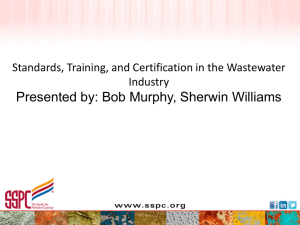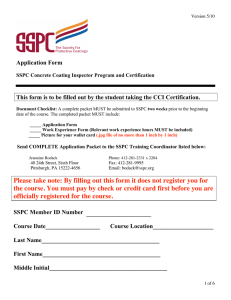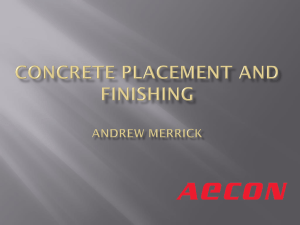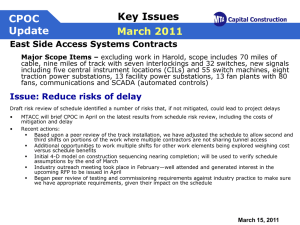Concrete Cleanliness Inspections - Laitance
advertisement
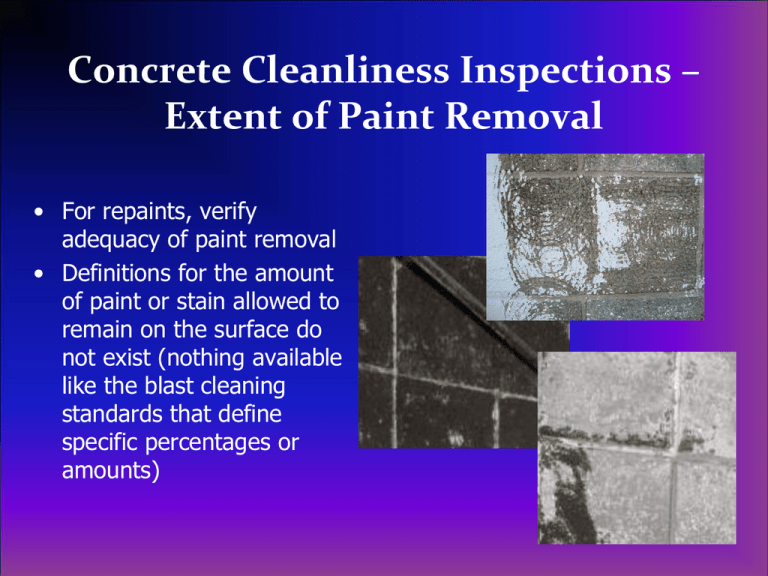
Concrete Cleanliness Inspections – Extent of Paint Removal • For repaints, verify adequacy of paint removal • Definitions for the amount of paint or stain allowed to remain on the surface do not exist (nothing available like the blast cleaning standards that define specific percentages or amounts) Concrete Cleanliness Inspections – Soundness of Remaining Paint • Extent/quality of feathering required • Test the integrity of the coating that remains after cleaning • Although not a standard for concrete cleaning, consider dull putty knife test Concrete Cleanliness Inspections – Roughness • Verify acceptable degree of substrate roughness – need to coordinate with Owner’s expectations • Standards showing varying degrees of roughness for given methods of preparation do not exist Concrete Cleanliness Inspections – Acid Etching • Confirm the thoroughness and degree of etching when using acid on floors • Typical comparison is medium grit sandpaper finish and measuring pH 4 Response to Industry Needs for Concrete Inspection Standards • A newly formed SSPC Commercial Coating Committee will be developing guides and standards to address the preceding concerns, and other concrete inspection issues • Committee meetings will be held on Feb 1, during the SSPC 2012 conference in Tampa 5 Inspect Concrete/Brick Moisture Content • The surface should be examined for unacceptable levels of moisture prior to painting. Sources of moisture include pressure washing, and external sources such as leaks and ground water • Test with moisture meters and plastic sheet, ASTM D4263 • The SSPC committee will be developing a guidance document to address test instruments, test locations, test frequency, and interpretation of results • Moisture testing is the subject of a webinar in March 2012 Moisture Testing - Identifies Potential Problems before Painting 7 Inspect for Removal of Gloss and Chalk • When overcoating, inspect the existing coating for chalk. Cleanliness can be tested by rubbing a clean black fabric (wool felt) across the surface and comparing the appearance of the residue with an ASTM rating scale (ASTM D4214) • Shiny surfaces should be inspected for removal of gloss to assure proper adhesion of the subsequent coats. There are no standards for the assessment, but the surface should be viewed from different angles to determine if shiny areas remain Summary - Surface Preparation Inspections of Metal and Concrete • • • • • • Standards are available for nearly all types of cleaning and inspection of metal substrates Limited standards are available for cleaning and inspection of cementitious surfaces, but SSPC is addressing it. Visual cleanliness inspections involve 100% of the surface Frequency of surface profile measurements (metal surfaces) is being established by SSPC Moisture detection of concrete is critical and standards are being developed by SSPC to address it For overcoating, gloss and chalk must be removed Monitor Ambient Conditions Poor Conditions can Impact Quality • Temperature, Relative Humidity, Dew Point/Surface Temp Relationship are critical for proper coating performance • Must be carefully monitored 10




